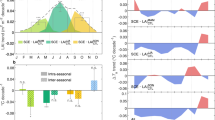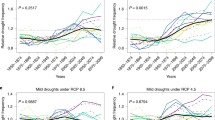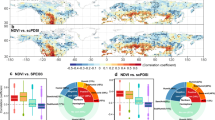Abstract
Climatic warming has greatly increased vegetation productivity in the extratropical Northern Hemisphere since the 1980s, but how long this positive relationship will continue remains unknown. Here we show changes in the effect of warming on Northern Hemisphere summer gross primary productivity for 2001–2100 using Earth system model outputs. The correlation between summer gross primary productivity and temperature decreases in temperate and boreal regions by the late twenty-first century, generally becoming significantly negative before 2070 in regions <60° N, though Arctic gross primary productivity continues to increase with further summer warming. The time when the correlation becomes negative is generally later than the time when summer temperature exceeds the optimal temperature for vegetation productivity, suggesting partial mitigation of the negative vegetation impacts of future warming with photosynthetic thermal acclimation. Our findings indicate that vegetation productivity could be impaired by climate change in the twenty-first century, which could negatively impact the global land carbon sink.
This is a preview of subscription content, access via your institution
Access options
Access Nature and 54 other Nature Portfolio journals
Get Nature+, our best-value online-access subscription
$29.99 / 30 days
cancel any time
Subscribe to this journal
Receive 12 print issues and online access
$209.00 per year
only $17.42 per issue
Buy this article
- Purchase on Springer Link
- Instant access to full article PDF
Prices may be subject to local taxes which are calculated during checkout



Similar content being viewed by others
Data availability
All data used in this study are openly available from the following: CMIP6 (https://esgf-node.ipsl.upmc.fr/search/cmip6-ipsl/); FLUXCOM GPP (http://fluxcom.org/CF-Download/); contiguous solar-induced fluorescence (https://osf.io/8xqy6/); CRU/NCEP temperature (https://dataguru.lu.se/app) and Topt (Huang et al15; https://www.nature.com/articles/s41559-019-0838-x). Any additional information may be obtained from the corresponding author upon reasonable request.
Code availability
All computer codes used in this study are available via GitHub at https://github.com/miniminiminimiffy/Productivity-Temperature.
References
Friedlingstein, P. et al. Global carbon budget 2020. Earth Syst. Sci. Data 12, 3269–3340 (2020).
Myneni, R. B. et al. A large carbon sink in the woody biomass of northern forests. Proc. Natl Acad. Sci. USA 98, 14784–14789 (2001).
Sitch, S. et al. Recent trends and drivers of regional sources and sinks of carbon dioxide. Biogeosciences 12, 653–679 (2015).
Kauppi, P. E. et al. Large impacts of climatic warming on growth of boreal forests since 1960. PLoS ONE 9, e111340 (2014).
Zhu, Z. C. et al. Greening of the Earth and its drivers. Nat. Clim. Change 6, 791–795 (2016).
Piao, S. L. et al. Characteristics, drivers and feedbacks of global greening. Nat. Rev. Earth Environ. 1, 14–27 (2020).
IPCC Climate Change 2013: The Physical Science Basis (eds Stocker, T. F. et al.) (Cambridge Univ. Press, 2013).
Penuelas, J. et al. Shifting from a fertilization-dominated to warming-dominated period. Nat. Ecol. Evol. 1, 1438–1445 (2017).
D’Arrigo, R., Wilson, R., Liepert, B. & Cherubini, P. On the ‘divergence problem’ in northern forests: a review of the tree-ring evidence and possible causes. Glob. Planet. Change 60, 289–305 (2008).
Beck, P. S. A. et al. Changes in forest productivity across Alaska consistent with biome shift. Ecol. Lett. 14, 373–379 (2011).
Vickers, H. et al. Changes in greening in the High Arctic: insights from a 30-year AVHRR max NDVI dataset for Svalbard. Environ. Res. Lett. 11, 105004 (2016).
Piao, S. L. et al. Evidence for a weakening relationship between interannual temperature variability and northern vegetation activity. Nat. Commun. 5, 5018 (2014).
Duffy, K. A. et al. How close are we to the temperature tipping point of the terrestrial biosphere? Sci. Adv. 7, eaay1052 (2021).
Liu, Y. W. et al. Seasonal responses of terrestrial carbon cycle to climate variations in CMIP5 models: evaluation and projection. J. Clim. 30, 6481–6503 (2017).
Huang, M. T. et al. Air temperature optima of vegetation productivity across global biomes. Nat. Ecol. Evol. 3, 772–779 (2019).
Park, T. et al. Changes in timing of seasonal peak photosynthetic activity in northern ecosystems. Glob. Change Biol. 25, 2382–2395 (2019).
Keeling, C. D., Chin, J. F. S. & Whorf, T. P. Increased activity of northern vegetation inferred from atmospheric CO2 measurements. Nature 382, 146–149 (1996).
Piao, S. L., Friedlingstein, P., Ciais, P., Viovy, N. & Demarty, J. Growing season extension and its impact on terrestrial carbon cycle in the Northern Hemisphere over the past 2 decades. Glob. Biogeochem. Cycles 3, GB3018 (2007).
Keenan, T. F. et al. Net carbon uptake has increased through warming-induced changes in temperate forest phenology. Nat. Clim. Change 4, 598–604 (2014).
Xia, J. Y. et al. Joint control of terrestrial gross primary productivity by plant phenology and physiology. Proc. Natl Acad. Sci. USA 112, 2788–2793 (2015).
Eyring, V. et al. Overview of the Coupled Model Intercomparison Project Phase 6 (CMIP6) experimental design and organization. Geosci. Model Dev. 9, 1937–1958 (2016).
Meehl, G. A. & Tebaldi, C. More intense, more frequent, and longer lasting heat waves in the 21st century. Science 305, 994–997 (2004).
Yamori, W., Hikosaka, K. & Way, D. A. Temperature response of photosynthesis in C3, C4, and CAM plants: temperature acclimation and temperature adaptation. Photosynth. Res. 119, 101–117 (2014).
Berry, J. & Bjorkman, O. Photosynthetic response and adaptation to temperature in higher plants. Annu. Rev. Plant Physiol. Plant Mol. Biol. 31, 491–543 (1980).
Chen, A., Huang, L., Liu, Q. & Piao, S. L. Optimal temperature of vegetation productivity and its linkage with climate and elevation on the Tibetan Plateau. Glob. Change Biol. 27, 1942–1951 (2021).
Smith, N. G., Lombardozzi, D., Tawfik, A., Bonan, G. & Dukes, J. S. Biophysical consequences of photosynthetic temperature acclimation for climate. J. Adv. Model. Earth Syst. 9, 536–547 (2017).
Chen, M. & Zhuang, Q. L. Modelling temperature acclimation effects on the carbon dynamics of forest ecosystems in the conterminous United States. Tellus B 65, 19156 (2013).
Crous, K. Y. Plant responses to climate warming: physiological adjustments and implications for plant functioning in a future, warmer world. Botany 106, 1049–1051 (2019).
Conley, M. M. et al. CO2 enrichment increases water-use efficiency in sorghum. New Phytol. 151, 407–412 (2001).
Norby, R. J. & Zak, D. R. Ecological lessons from free-air CO2 enrichment (FACE) experiments. Annu. Rev. Ecol. Evol. Syst. 42, 181–203 (2011).
Huang, M. T. et al. Change in terrestrial ecosystem water-use efficiency over the last three decades. Glob. Change Biol. 21, 2366–2378 (2015).
Gonsamo, A. et al. Greening drylands despite warming consistent with carbon dioxide fertilization effect. Glob. Change Biol. 7, 3336–3349 (2021).
Keenan, T. F. et al. Increase in forest water-use efficiency as atmospheric carbon dioxide concentrations rise. Nature 499, 324–327 (2013).
Lemordant, L. et al. Modification of land–atmosphere interactions by CO2 effects: implications for summer dryness and heat wave amplitude. Geophys. Res. Lett. 43, 10240–10248 (2016).
Lian, X. et al. Summer soil drying exacerbated by earlier spring greening of northern vegetation. Sci. Adv. 6, eaax0255 (2020).
Lian, X. et al. Multifaceted characteristics of dryland aridity changes in a warming world. Nat. Rev. Earth Environ. 4, 232–250 (2021).
Druel, A., Ciais, P., Krinner, G. & Peylin, P. Modeling the vegetation dynamics of northern shrubs and mosses in the ORCHIDEE land surface model. J. Adv. Model. Earth Syst. 11, 2020–2035 (2019).
Scheiter, S., Langan, L. & Higgins, S. I. Next-generation dynamic global vegetation models: learning from community ecology. New Phytol. 198, 957–969 (2013).
Mod, H. K. & Luoto, M. Arctic shrubification mediates the impacts of warming climate on changes to tundra vegetation. Environ. Res. Lett. 12, 124028 (2016).
Zhang, Y., Commane, R., Zhou, S., Williams, A. P. & Gentine, P. Light limitation regulates the response of autumn terrestrial carbon uptake to warming. Nat. Clim. Change 10, 739–743 (2020).
Bauerle, W. L. et al. Photoperiodic regulation of the seasonal pattern of photosynthetic capacity and the implications for carbon cycling. Proc. Natl Acad. Sci. USA 109, 8612–8617 (2012).
Zhang, Y., Parazoo, N. C., Williams, A. P., Zhou, S. & Gentine, P. Large and projected strengthening moisture limitation on end-of-season photosynthesis. Proc. Natl Acad. Sci. USA 117, 9216–9222 (2020).
Fritz, M. et al. Brief communication: future avenues for permafrost science from the perspective of early career researchers. Cryosphere 9, 1715–1720 (2015).
Jin, X. Y. et al. Impacts of climate-induced permafrost degradation on vegetation: a review. Adv. Clim. Change Res. 12, 29–47 (2021).
Tramontana, G. et al. Predicting carbon dioxide and energy fluxes across global FLUXNET sites with regression algorithms. Biogeosciences 13, 4291–4313 (2016).
Zhang, Y., Joiner, J., Alemohammad, S. H., Zhou, S. & Gentine, P. A global spatially contiguous solar-induced fluorescence (CSIF) dataset using neural networks. Biogeosciences 15, 5779–5800 (2018).
Navarro-Racines, C., Tarapues, J., Thornton, P., Jarvis, A. & Ramirez-Villegas, J. High-resolution and bias-corrected CMIP5 projections for climate change impact assessments. Sci. Data 7, 7 (2020).
Acknowledgements
This study was supported by the National Natural Science Foundation of China (41988101) and the Second Tibetan Plateau Scientific Expedition and Research programme (grant no. 2019QZKK0405). A.C. acknowledges the support from a US Department of Energy grant (DE-SC0022074). B.M.R. thanks support from the National Aeronautics and Space Administration (NASA) Arctic-Boreal Vulnerability Experiment (ABoVE) and Carbon Cycle Science programs (NNX17AE13G) and the Gordon and Betty Moore Foundation (grant #8414).
Author information
Authors and Affiliations
Contributions
S.P. designed the research, Y.Z. performed the analysis and drafted the figures, Y.Z. and S.P. wrote the first draft of the manuscript and all authors contributed to the interpretation of the results and to the text.
Corresponding author
Ethics declarations
Competing interests
The authors declare no competing interests.
Peer review
Peer review information
Nature Climate Change thanks Alexander Koch and Sassan Saatchi for their contribution to the peer review of this work.
Additional information
Publisher’s note Springer Nature remains neutral with regard to jurisdictional claims in published maps and institutional affiliations.
Supplementary information
Supplementary Information
Supplementary Figs. 1–12 and Tables 1–3.
Rights and permissions
About this article
Cite this article
Zhang, Y., Piao, S., Sun, Y. et al. Future reversal of warming-enhanced vegetation productivity in the Northern Hemisphere. Nat. Clim. Chang. 12, 581–586 (2022). https://doi.org/10.1038/s41558-022-01374-w
Received:
Accepted:
Published:
Issue Date:
DOI: https://doi.org/10.1038/s41558-022-01374-w
This article is cited by
-
Diminishing carryover benefits of earlier spring vegetation growth
Nature Ecology & Evolution (2024)
-
Solar-Induced Chlorophyll Fluorescence (SIF): Towards a Better Understanding of Vegetation Dynamics and Carbon Uptake in Arctic-Boreal Ecosystems
Current Climate Change Reports (2024)
-
The impacts of aridification on land surface phenological changes in the farming-pastoral ecotone of northern China based on the climatic zoning method
Theoretical and Applied Climatology (2024)
-
Reassessment of growth-climate relations indicates the potential for decline across Eurasian boreal larch forests
Nature Communications (2023)
-
Hydroclimatic extremes contribute to asymmetric trends in ecosystem productivity loss
Communications Earth & Environment (2023)



